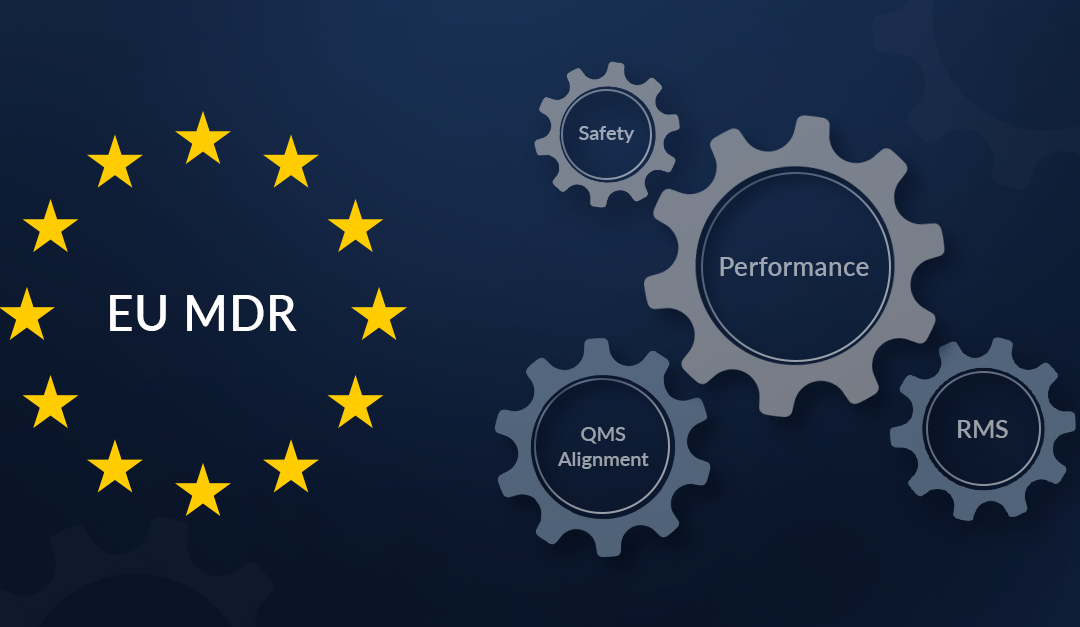The European Union Medical Device Regulation (EU MDR) was published on May 5, 2017 and came into force on May 26, 2021. Some of the major themes in MDR include the introduction of new concepts (e.g., SSCP), modification of the existing concepts (e.g., PMS, PMCF), introduction of timelines (e.g., PMS, PMCF, SSCP), broad transition from a pre-approval to a life-cycle approach, and substantial challenges in taking the equivalence approach, with a very important factor being the determination of safety and performance (S&P) objectives. This is because S&P objectives are directly linked to the end goal of the MDR, which is for patients to benefit from the updated processes.
Manufacturers often struggle with understanding the best way to determine these objectives and ensuring that they serve the overall purpose of clearly informing the safety, performance, and benefits of the devices. Taking a step back to keep a few simple things in mind before proceeding with any of the larger MDR deliverables can go a long way in maintaining an efficient workflow, thereby meeting deadlines, ensuring continuous access to the EU market, and most importantly, ensuring that patients can benefit from your cutting-edge technology.
Simple things to consider before identifying S&P objectives
Here are a few things to consider before determining S&P objectives:
1. Level of events: What is the type of device that you are looking at; is it a side-character in a larger procedure, or is it the hero of the procedure? Based on your answer to this question, you can pick what kind of outcomes would best inform the clinical profile of your device. If it is an accessory or derives its intended clinical benefit indirectly via the benefits of the procedure, go for procedure-specific measures. If the intended clinical benefits are direct, pick device-specific measures. If you are unsure, a quick review of the available literature always helps!
2. Terminology: The terms used to define your measures are extremely important – you don’t want these to be too specific (and end up getting no outcomes) or too broad (and end up reporting almost everything under a single measure). A quick review of the available clinical data (literature and investigations) either on your device or on similar devices can help understand what data are out there, so you can define your measures in a way such that most of the relevant clinical data can be captured and appropriately analyzed.
3. Grouping of terms: Linking to the previous point about broad terms, this might actually work in your favor many times. Grouping similar adverse events under one bucket helps capture a lot more data, e.g., terms such as hematoma, access site injury, and perforation can all be grouped under vascular injury. Of course, clinical input is always advisable to ensure the data remain meaningful.
4. Timepoint of the event: Another important consideration is that of the timepoint at which the outcomes are reported. These can be defined based on the type of device, duration of benefit of the device, and the available clinical data. Deciding the timepoint from the get-go helps maintain alignment throughout the documentation and makes the data easy to analyze and compare across the board.
5. Units of measure: Similar to timepoint, deciding units from the get-go also makes your data easy to analyze. You can decide on the units based on available clinical data (clinical literature, clinical investigations).
6. Acceptance criteria: The most dreaded consideration of all – how do you define the acceptance criteria for each of the measures? This is what will help with your analysis because all the outcomes reported for the defined measures will be finally compared with these acceptance criteria. There are several ways of doing this, but our go-to technique would be to look at the outcomes reported by similar devices for the pre-determined measures. This method also addresses a secondary objective of clinical evaluation – ensuring that your device is well positioned within the state of the art. When you have a million things to take care of, what could be better than killing two birds with one stone! Some other methods of determining acceptance criteria include looking at rates reported by risk management or even rates reported by your subject device in controlled settings (e.g., in clinical trials). The last method works well when your device defines the state of the art in the therapeutic area and there is not a lot to compare against.
These considerations are just a few examples of aspects that can be scrutinized to determine the S&P objectives. It is important to ensure cross-functional involvement in these decisions. This cross-functional team may consist of members and representatives from the following arms: Regulatory, Product Management, Engineering, Post Market, Quality, Clinical Affairs, and Medical Affairs. Notably, the clinical team plays a crucial role in these discussions since they have a deep understanding of the outcomes that may be reported during a procedure involving the subject device.
Unfortunately, the industry still struggles with defining these objectives clearly, and rightfully so, because it is a Herculean task and one size does not fit all. Once everyone is on the same page and speaking the same language, it becomes easier to start to align processes and share data and information seamlessly across the board, with a common goal of proving a device’s safety and performance. Furthermore, since the perfect dataset does not exist, it is necessary to find quality data within each of the processes and to know how to use this information to the fullest extent possible, as these decisions impact patient safety.
For more information on this topic, watch our “Data-driven QMS Alignment Series” on YouTube. Contact us to learn how we can help you with every aspect of the CER process, QC support, CEP development, PMCF plan, PERs, CER Remediation Support/Notified Body Response, IVDR, and more, to keep your devices compliant with rapidly changing regulations.















